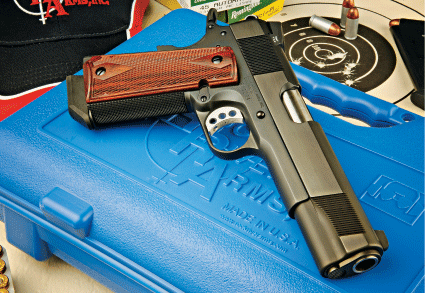Although I have known about Rock River Arms (RRA) for quite some time, I never really became acquainted with their products until a couple of years ago, when I attended a three-day shooting event at the SIG SAUER’S Academy organized by Media Direct, a marketing company that represents both RRA and SIG SAUER. During this “shoot-fest” I was introduced to RRA AR-15 rifles/carbines, and their quality got me interested in their line of custom 1911 pistols.
I say custom because actually they are; RRA does not make a 1911 unless you order it and then, like a popular fast food chain, you can “have it your way.” From what I understand, once you make your order, it can take around four months to complete your pistol. And the gunsmiths at RRA won’t even let the pistol out the door unless it is 100 percent reliable and will shoot a 2.5-inch group at 50 yards with Federal Gold Metal Match 185-grain SWC .45ACP ammo.
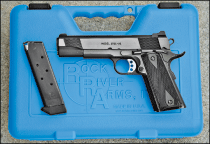 Gun Details
Gun Details
I had previously done a test and evaluation (T&E) on RRA’s new Tactical 1911A1 pistol, so when Harris Publications asked me to check out another RRA handgun, I jumped at the opportunity. I contacted Media Direct and in short order, I had a Pro Carry model delivered to my doorstep. The Pro Carry is largely “GI” in appearance and comes without the guide rod seen on a lot of 1911 pistols these days. That being said however, the Pro Carry does have an impressive list of standard factory features and my sample had a couple that I did not see mentioned on the RRA website.
Advertisement — Continue Reading Below
The test 1911A1 came with a National Match (NM) frame with 30 lines-per-inch (LPI) checkering on the front strap of the grip frame and on the flat mainspring housing of the back strap (arched mainspring housing is optional, as is 20 and 25 LPI checkering). Also on the back strap is a beavertail grip safety that completely eliminates hammer bite. There is also an extended tactical safety lever that is unobtrusively designed, yet easy to use when you are “wiping-off” the safety for a rapid shot. The magazine release button is also of the tactical variety and extends out just a bit further than the standard magazine catch to assist with rapid combat reloads. An aluminum speed trigger, adjustable for overtravel, is also included and is factory set for a 3.5-pound pull and is one of the few non-black parts on this gun. It is a bit longer than the usual trigger on a GI 1911A1 and is reminiscent of the original 1911 trigger, except for the 3 holes drilled in the side and one in the lower serrated trigger face. The hammer is what someone might call “Commander-style,” but is more skeletonized than the simple round hole of the original Commander-type hammer. The slide release catch is strictly GI, which is fine by me.
Atop the frame is a forged NM slide with serrations fore and aft that offers a good purchase when racking back the slide or taking a quick peek to see if you have a round up the spout. This particular gun was fitted with the standard Heinie fixed rear sight with tritium inserts. This is a ruggedly designed sight, dovetailed into the slide and one can make rudimentary windage adjustments by loosening a hex head screw in the top of the sight base and moving the sight laterally in the dovetail. The rear of the sight is finely serrated to reduce glare and the rear notch is a generous 0.126 of an inch wide. The front sight is also dovetailed into the slide and has a tritium insert and serrated blade.
The ejection port has been lowered and squared and the Pro Carry is fitted with a tuned and polished extractor, plus an extended ejector to kick that expended brass out with aplomb. The 5-inch KART NM barrel is throated and the feed ramp polished mirror bright for smooth cartridge feeding. The slide is fitted with a NM bushing and I noted that the front of the barrel near the muzzle is 0.583 of an inch in diameter, while about one-third of an inch back the barrel diameter is reduced to 0.577 of an inch; it’s not real obvious, but this precision fit is what produces those tight groups RRA 1911 pistols are known for.
Advertisement — Continue Reading Below
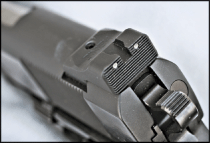 For carrying comfort, all the sharp edges on the Pro Carry have been removed and along with this “dehorning,” the edges of the magazine well have been beveled for easier insertion of the magazine when things are getting sticky. The test gun had a lustrous blue finish on the flat surfaces of the slide and frame, while the top of the slide, bottom of the frame dustcover, triggerguard, and front and back straps of the grip frame were matte finished. If you wish, you can also get the optional Black “T” finish that looks a lot like a matte Teflon-like coating.
For carrying comfort, all the sharp edges on the Pro Carry have been removed and along with this “dehorning,” the edges of the magazine well have been beveled for easier insertion of the magazine when things are getting sticky. The test gun had a lustrous blue finish on the flat surfaces of the slide and frame, while the top of the slide, bottom of the frame dustcover, triggerguard, and front and back straps of the grip frame were matte finished. If you wish, you can also get the optional Black “T” finish that looks a lot like a matte Teflon-like coating.
Finally, my gun came with some new black micarta checkered grip panels in place of the standard rosewood slabs. Both feature the old-style checkering pattern with the diamonds at the grip screws. You can also have your Pro Carry with a 4.25-inch barrel/slide or a 6-inch barrel/slide and a Novak rear sight with tritium inserts. Each pistol comes in a RRA blue plastic carrying case and includes a single magazine made by Kileen Machine Tool Co., known for their military rifle magazines.
Capacity is 7+1 cartridges and the magazine has a rounded follower for more positive cartridge feeding. The base-plate of the magazine has a polymer bumper pad attached with two hex-head screws, which can be removed. The pad aids in both magazine seating and protects the magazine from shock when it hits the ground or pavement, and the empty magazine pops out of the Pro Carry with authority.
Advertisement — Continue Reading Below
Base price of the Pro Carry is $1,795 and, for that, you get a 1911A1 pistol that not only works when you need it to work and hits what you are shooting at, but looks good too. My examination of the exterior of the test pistol disclosed no flaws in metal-to-metal fit and the gun is put together like a well-made Swiss watch.
My one complaint was the magazine catch lock plate on the right side of the pistol was a little overdone in the bluing tank and it came out a plum color, a small detail I didn’t notice until the light hit it just right. But, overall, as the name implies, this is a very professional-looking piece of hardware and with the proper care will no doubt be an heirloom that can certainly be passed down for generations.
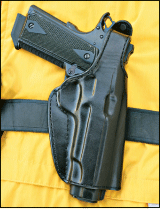 Holsters
Holsters
I’ve always liked 1911s and have carried vintage World War II production models as a Reserve Officer in the Army National Guard and have at various times packed one during my law enforcement career as an off-duty gun. The 1911 lends itself well to just stuffing in the waistband behind the hip, but this “Mexican Carry” can be a little iffy in the cocked-and-locked mode. I think you are better off using a quality holster rig and I favor a belt holster with the strong-side carry, as I tend to reach for a gun in this area for a crossdraw, or use a shoulder holster carry.
Advertisement — Continue Reading Below
I rummaged through my holster collection and came up with a custom hip holster made for me several years ago by Chris Brown of Little Feather Leatherworks (LFL). The “Chief” works out of a small shop in Southern Indiana and has been crafting with cowhide for some 25 years. He makes duty and off-duty rigs for area law enforcement officers, belt and holster outfits for Cowboy Action Shooters, and his extensive line covers just about anything anyone would need who packs.
The rig I have is the LFL-6, Hi-Ride Belt Holster, which features a leather belt slot, stitched on back and suede lined with reinforced thumb break and fits up to 1.75-inch belts. Mine was originally made for a Commander-size 1911, but I found the open bottom of this holster accommodates the RRA Pro Carry just fine and the large sight gutter built into the holster keeps the front sight from dragging on the leather.
My LFL-6 was dyed black and has a glossy finish and displays superb craftsmanship. I’m not just blowing smoke when I state that LFL product compares with any of the “big names” in the holster business.
Advertisement — Continue Reading Below
Range Time
Now that I had suitable leather, it was time to check out my ammo locker to see what might be some good test loads in .45ACP caliber. One of my favorite loads and the one I carry in my Commander-length 1911A1 is the CorBon 165-grain JHP +P. This is a fast-stepping number out of a 5-inch tube and its conical hollow point (HP) bullet has a deep cavity, while the jacket extends up to the bullet nose and is notched to aid in expansion.
Next up the weight scale is the Federal Classic 185-grain Hi-Shok JHP. The 185-grain bullet was one of the first reduced weight with increased velocity loads in .45ACP and this offering from Federal has a very flat nose profile and a gaping hollow point. This cartridge will be the acid test for the polish job and throating on the Pro Carry’s feed ramp and chamber.
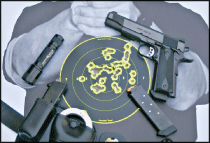 At 200 grains, the Norma Diamond cartridge has a “Molycoated” bullet that is pushed along at +P velocities. This bullet has a more rounded nose and a somewhat shallow hollow point and should function well in most .45 semi-automatics. In traditional bullet weights of 230 grains, I have the Black Hills JHP load, with a bullet that looks almost identical to that in the Norma load, only heavier and should also feed well. I also have the Winchester Ranger, a +P load that features the SXT hollow point bullet with a unique scalloped jacket nose to encourage bullet expansion. It also has a rounded profile that should make it a reliable performer in the Pro Carry.
At 200 grains, the Norma Diamond cartridge has a “Molycoated” bullet that is pushed along at +P velocities. This bullet has a more rounded nose and a somewhat shallow hollow point and should function well in most .45 semi-automatics. In traditional bullet weights of 230 grains, I have the Black Hills JHP load, with a bullet that looks almost identical to that in the Norma load, only heavier and should also feed well. I also have the Winchester Ranger, a +P load that features the SXT hollow point bullet with a unique scalloped jacket nose to encourage bullet expansion. It also has a rounded profile that should make it a reliable performer in the Pro Carry.
Advertisement — Continue Reading Below
I packed up my gear and headed to the range on a warm early June afternoon for some shooting impressions and chronographing session. I launched 10 rounds each of the test ammo through my Oehler Model 35P chronograph to get some bullet velocity readings and also break in the Pro Carry before I started the actual shooting evaluation and testing.
I was using some multiple bull’s-eye type targets, which makes for less up-and-down at the range and less aggravation for those around you. As the targets are reduced size and orange, I set them up at 30 feet and felt this was a fair test, as the aiming point was about the same as I would get with a 25-yard slow-fire target. That and my 53-year-old eyes had some trouble seeing those targets farther than that.
My test regimen was five 5-shot groups with each brand of .45ACP cartridge from a rest position. I actually fired standing up, using the top of my rigid nylon shooting bag as a rest. No machine rests, benches or sandbags, I just wanted to see what I could do with this gun, using an impromptu rest and firing a fairly rapid 5-round string, breaking only long enough to load magazines. The surprise was that I was able to keep all my shots inside the scoring rings of those bull’s-eyes!
Advertisement — Continue Reading Below
Only one group measured over 2.5 inches and that was due to a called flyer; the rest averaged 1.77 inches for 125 rounds downrange. The best of the day was awarded to Federal’s Classic 185-grain JHP with a tiny cluster of 0.71 of an inch (it was also voted “Most Pleasant to Shoot”) and I had a 4-hole group with the Norma 200-grain JHP +P that ran 0.50 of an inch until a flyer opened it up to 2.05 inches. Official second place went to Black Hills 230-grain JHP with a 0.99 of an inch group and none were cause for an embarrassment whatever.
After having shot some 175 rounds, discounting a number of “plinkers,” my observations were mostly on the positive side. I was most impressed with the sights and how well they stood out, allowing me to do my best with the trigger and breath control. That trigger pull took a little getting used to and a few I touched off were truly a surprise. I had to tighten the screws on the right-side grip panel three times during T&E, and I had some feed ramp jams with at least three brands of cartridges that I would not have expected. More break-in time will probably cure that.
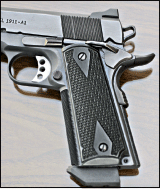 For some combat shooting I put up a human photo silhouette and added a self-adhesive bull’s-eye target in the K-zone. I loaded up all three magazines I had and proceeded to fire at ranges from 3 to 15 yards, doing strong-hand-only point shooting up close, double and triple taps with a flash sight picture at 21 feet and some left-side, right-side barricade and kneeling barricade at 15 yards. The Pro Carry was started from a snapped holster, and the Little Feather Leatherworks rig on my right hip performed very well.
For some combat shooting I put up a human photo silhouette and added a self-adhesive bull’s-eye target in the K-zone. I loaded up all three magazines I had and proceeded to fire at ranges from 3 to 15 yards, doing strong-hand-only point shooting up close, double and triple taps with a flash sight picture at 21 feet and some left-side, right-side barricade and kneeling barricade at 15 yards. The Pro Carry was started from a snapped holster, and the Little Feather Leatherworks rig on my right hip performed very well.
I had one hit on the very edge of the bull’s-eye that just nicked the edge of the target; the rest were all inside. I had no malfunctions using Black Hills and Norma ammo for this test phase, and the Pro Carry handled well.
Advertisement — Continue Reading Below
Final Notes
If you are in the market for a custom combat handgun without going to one of the small custom pistol makers, then you might want to check out the several models and variations available from Rock River Arms.
